Back to: MICROBIOLOGY 200 LEVEL
Welcome to class!
Hello, superstar! I’m so happy to have you here today. You know how we humans have different lifestyles—some people prefer quiet village life while others enjoy the hustle and bustle of city life? Microorganisms are kind of like that too. Even though they’re tiny, they don’t all live, grow, or function the same way. Today, we’ll be talking about the Differences Between Prokaryotic and Eukaryotic Physiology. This simply means we’re going to understand how these two groups of microbes “live their lives” differently—from how they eat, to how they grow, and even how they make energy
Differences Between Prokaryotic And Eukaryotic Physiology.
Understanding Physiology in Microorganisms
Physiology refers to all the functions and processes that keep an organism alive—things like breathing (respiration), feeding (nutrition), growing, moving, and reproducing. Just like how your body works differently from a bird’s or a fish’s, prokaryotic and eukaryotic microorganisms also have different internal systems and processes that help them survive.

Let’s use a simple analogy: imagine comparing a keke (tricycle) to a luxury bus. Both can carry people, but the way they operate, the features they have, and how fast or far they can go are very different. That’s the same way prokaryotes and eukaryotes differ in physiology.
Major Differences in Physiology
Cell Structure and Organisation
Prokaryotes (like bacteria) are simple. They have no true nucleus or membrane-bound organelles.
Eukaryotes (like fungi and protozoa) are more complex, with a true nucleus and many organelles like mitochondria and Golgi bodies.
Energy Production (Respiration)
In prokaryotes, energy is usually produced on the inner surface of the cell membrane, since they don’t have mitochondria.
Eukaryotes generate energy in mitochondria—specialised organelles known as the “powerhouse” of the cell.
Reproduction
Prokaryotes reproduce asexually by binary fission—like a photocopy machine making exact copies.
Eukaryotes can reproduce both asexually and sexually. Sexual reproduction allows more variation, like mixing traits from two parents.
Protein Synthesis
Prokaryotes have smaller ribosomes (70S), while eukaryotes have larger ones (80S).
Their processes for building proteins also differ in speed and complexity.
Motility
Many prokaryotes move using simple structures like flagella, made of a protein called flagellin.
Eukaryotic cells have more complex movement structures, like cilia or undulating flagella with a 9+2 microtubule structure.
Cell Wall Composition
In prokaryotes, especially bacteria, the cell wall is mainly made of peptidoglycan.

In eukaryotic microbes like fungi, the cell wall (if present) is made of chitin or cellulose.
Imagine a small family buka in Ibadan cooking with firewood and grinding pepper with a stone, while a modern Lagos restaurant uses a gas cooker, blender, and microwave. They both serve food, but how they do it is totally different. That’s how prokaryotic and eukaryotic microbes function—they may achieve the same basic goals, but their methods are quite distinct.
Summary
- Prokaryotic and eukaryotic cells have different physiologies based on structure and function.
- Prokaryotes are simpler: no nucleus, no mitochondria, smaller ribosomes.
- Eukaryotes are more advanced: with specialised organelles, larger ribosomes, and complex reproduction.
- Their energy production, movement, protein synthesis and cell wall composition also differ.
Evaluation
- Where does energy production happen in prokaryotic cells?
- Name two differences in how prokaryotes and eukaryotes reproduce.
- Which type of microbial cell uses peptidoglycan in its cell wall?
- In your own words, compare a bacterial cell to a fungal cell using a local analogy.
You’ve just tackled a really important concept—well done! Understanding the differences in how microbes work is like having a secret key to unlock many wonders in microbiology. Keep going strong—your mind is sharp, your future is bright, and with Afrilearn, learning will always feel like a friendly conversation. See you in the next class, champ!
